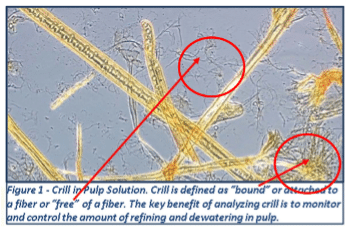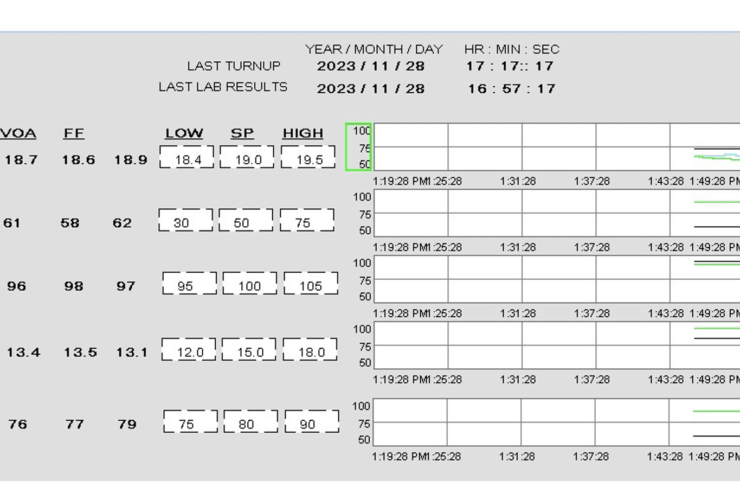Traditional recycled containerboard mill wisdom was to maximize the use of lower cost Mixed Paper (MP) and reduce the use of higher cost Old Corrugated Containers (OCC) to optimize furnish costs. OCC and MP costs are variable, and short-term furnish cost optimization opportunities may merit attention. Previously we presented a theoretical case study in which measurement of furnish quality can yield big savings through increased usage of lower-cost MP. In this article, we address another scenario with MP and OCC that demonstrates the importance of subject matter expertise to yield realistic expectations.
The Scenario
In this scenario, we consider reducing the required amount of starch when more OCC is used. Due to the lower quality of MP, additional wet ends and size press starch are used at higher MP usage in order to improve strength. By increasing the utilization of OCC, we can save on those chemical costs.
As in the prior case, we will use as a basis a 1,000 dry tons/day production rate, which is 350,000 dry tons/year. We will use an initial furnish ratio of 90% OCC and 10% MP. OCC typically has a yield of 90% (10% shrink–yield loss from contaminants removed in recycled fiber processing). MP typically has a lower yield of 85%. This results in fiber demand as follows:
- OCC demand = (350,000 dry tons/year)(90% from OCC)/(90% yield) = 350,000 dry tons OCC/year
- MP demand = (350,000 dry tons/year)(10% from OCC)/(85% yield) = 41,176 dry tons MP/year
Increasing OCC to save on chemical (starch) costs
If we knew more about fiber quality, we could have the confidence to increase the contribution of OCC. This contrasts the prior case where we increased MP due to its lower cost. In this case, we are increasing OCC to save on chemical (starch) costs. This is possible with PulpEye. PulpEye provides a complete analysis of fiber quality in real time. Let’s assume that PulpEye gives us the information we need to increase OCC by 10%. That would result in the following fiber demand:
- OCC demand = (350,000 dry tons/year)(100% from OCC)/(90% yield) = 388,889 dry tons OCC/year
- MP demand = (350,000 dry tons/year)(0% from OCC)/(85% yield) = 0 dry tons MP/year
The increased use of OCC may require less wet-end starch to maintain STFI quality targets. The typical application of wet-end starch is 16 pounds/ton of dry fiber, but eliminating MP from the blend can lower this to 14.5 pounds/ton of dry fiber. Therefore, the difference in starch demand is calculated as:
- At 10% MP, (350,000 dry tons/year)(16 pounds wet-end starch/dry ton) = 5,600,000 pounds wet-end starch/year
- At 0% MP, (350,000 dry tons/year)(14.5 pounds wet-end starch/dry ton) = 5,075,000 pounds wet-end starch/year
This difference is 525,000 pounds less starch per year at 0% MP. A typical cost for wet-end starch is $0.40/pound, so the cost savings would be $210,000 per year.
Starch is also applied at the size press. The typical application of size press starch is 80 pounds/ton of dry fiber, but eliminating MP from the blend can lower this to 65 pounds/ton of dry fiber. Therefore, the difference in starch demand is calculated as:
- At 10% MP, (350,000 dry tons/year)(80 pounds wet end starch/dry ton) = 28,000,000 pounds wet end starch/year
- At 0% MP, (350,000 dry tons/year)(65 pounds wet end starch/dry ton) = 22,750,000 pounds wet end starch/year
This difference is 5,250,000 pounds less starch per year at 0% MP. A typical cost for size press starch is $0.32/pound, so the cost savings would be $1,680,000 per year.
Impact on Waste From Eliminating MP
There is also a difference in waste treatment. MP will increase the load and cost. The impact on waste from eliminating MP for this case is calculated as:
- At 10% MP, the wasted portion of OCC (with a yield of 90%) is the amount of OCC demanded (350,000 dry tons/year)(10% waste) = 35,000 dry tons/year. The wasted portion of MP (with a yield of 85%) is the amount of MP demanded (41,176 dry tons/year)(15% waste) = 6,176 dry tons/year. This adds up to 41,176 dry tons/year of wasted fiber to be treated. 80% of this fiber will go to wastewater treatment, and 90% of that amount is bone dry fiber, yielding 29,647 tons/year. Considering that this is a solution that is typically 60% solids, the mass of wet sludge is (29,647 tons/year)/(60% solids) = 49,412 tons/year of wet sludge to be treated. At a typical cost of $43/ton for waste treatment, this amounts to $2,124,705/year.
- Doing the same analysis at 0% MP, the wasted portion of OCC (with a yield of 90%) is the amount of OCC demanded (388,889 dry tons/year)(10% waste) = 38,889 dry tons/year. The wasted portion of MP when it is eliminated is 0. This adds up to 38,889 dry tons/year of wasted fiber to be treated. Assuming 80% of this fiber will go to wastewater treatment, and 90% of that amount is bone dry fiber, that yields 28,000 tons/year. Considering that this is a solution that is typically 60% solids, the mass of wet sludge is (31,294 tons/year)/(60% solids) = 46,667 tons/year of wet sludge to be treated. At a typical cost of $43/ton for waste treatment, this amounts to $2,006,667/year.
Therefore, the cost savings of treating waste with no MP in the blend is $118,039/per year
We now see that eliminating MP saves $210,000 /year in wet-end starch, $1,680,000/year in size press starch, and $118,039/year in waste treatment. This is a total savings of $2,008,039/year.
We now need to consider the increased fiber cost by replacing MP with OCC. We will first assume the reduced pricing that we are currently in the marketplace. The current price for OCC is approximately $40/ton, while MP is near $0/ton.
- At 10% MP, the fiber cost would be (350,000 tons OCC/year)($40/ton OCC) + (41,176 tons MP/year)($0/ton MP) = $14,000,000/year
- At 0% MP, the fiber cost would be (388,889 tons OCC/year)($100/ton OCC) = $15,555,555/year
This is an increased fiber cost of $1,555,555/year. Subtracting the chemical and waste saving from above $2,008,039/year, the net savings is $452,483/year
However, if we evaluate the same case for pricing that we have traditionally seen in the industry, we get a different result. Typical pricing in the industry in recent years has OCC at $100/ton and MP prices at $40/ton. Substituting those numbers in the calculation above, we return a loss of $233,790/year in savings by increasing OCC to 100%.
The Conclusion
The conclusion is that results depend on an honest evaluation by people with subject matter expertise in the paper industry. In some cases, significant benefits can be discovered and delivered with the right partner. In other cases, a partner can help you avoid investments that waste your money. Either case is better than a vendor that overpromises and cannot deliver.
Subject matter expertise and honesty are required to give you guidance that you can trust. Let Pulmac be your partner to optimize your furnishing.






